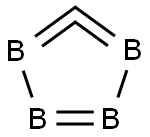-
外観
灰黒色の粉末
-
種類
炭化ホウ素はバルク形状、粉末状など様々な形態で扱われています。バルク形状の炭化ホウ素は、素板やノズル、密封シール、ペレットなどのセラミックス製品に加工され、防弾関係、サンドブラスト、ウォータージェット技術、機械密封などに応用されます。粒子状の炭化ホウ素は高硬度材料で作られた製品の研磨材、耐火物酸化防止材、SiC焼結助剤などに用いられます。粒子状の場合、用途によって粒径が揃った炭化ホウ素が用いられます。
-
性質
分子量は55.25、比重は2.51、融点は2350 ℃です。高融点、高硬度、低比重、耐熱性、耐薬品性、中性子吸収能などの特性を備えています。
塩素に対しては高温で反応し、三塩化ホウ素が生成します。酸素に対しては抵抗力が弱く、粉末状のものは570 ℃から酸化され始めます。一般的に酸やアルカリには侵されませんが、アルカリ融解やフッ化水素酸を含む酸により分解・可溶化されます。酸によって分解する場合、フッ化水素酸と硝酸の混酸による加圧分解法が用いられます。
-
溶解性
水, 酸に不溶。
-
解説
炭化四ホウ素B4Cと一般に表されるが,実際はB4CからB10.4Cまである.工業的には酸化ホウ素と炭素とを 2500~2600℃に加熱して製造する。Cの割合が低いものはαりょう面体晶系ホウ素の固溶体とされる.B4C(55.26)は1900 ℃ 以下ではα型,以上ではβ型になる.B2O3とCを電気炉中で1400~2300 ℃ に加熱してつくる.2B2O3 + 7C → B4C + 6CO構造的には,B12 二十面体が直鎖状の C3 でつながった形のB12C3のりょう面体結晶である.黒色で硬く,ダイヤモンドとBNにつぐ硬さをもつ.密度2.51 g cm-3(25 ℃).融点2350 ℃.不活性気体中では溶融しても分解しない.酸素中で加熱しても800 ℃ までは安定である.耐化学薬品性も大きく,室温では酸・アルカリに侵されない.高温・高圧下では濃硝酸に徐々に侵される.硬く,耐化学薬品性も大きいことから,切削工具,研磨剤,粉末を加熱加圧成型した器具の製造などに用いられる.研磨材,耐火材料,金属加工具などに使用される。また金属と接合したサーメットもつくられる.このほか原子炉制御材(中性子吸収材)にも使用される.[CAS 12069-32-8:B4C][CAS 12075-36-4:B12C3]
森北出版「化学辞典(第2版)
-
用途
原子炉制御材,遮へい材
-
構造
炭化ホウ素の結晶構造は菱面体晶型です。対角線上に3個の炭素原子をもつ菱面体単位格子の各頂点にホウ素の正二十面体を形成する構造です。
対角線上の炭素連鎖の中央部は特にホウ素によって置換されやすく、また二十面体のホウ素が逆に炭素によって一部置換することもあります。元素の置換のみで結晶の骨格は変わらないため、粉末 X 線回折図形のピーク数や強度比はほとんど変わりません。
-
説明
Sodium tetraborate decahydrate/borax (anhydrous) is a clear, colorless or pale yellow
hygroscopic substance with a faint odor of detergent. It is stable and is incompatible with
powdered metalsand slightly soluble in water. It is extensively used in the industrial manufacturing
of metallurgical fluxes, fiberglass, ceramics, fertilizers, enamels, heat-resistant
glass (e.g., Pyrex), and other chemicals. It decomposes on heating or on burning producing
toxic fumes including sodium oxide, reacts with strong oxidants, and in fire gives off
irritating or toxic fumes (or gases).
-
化学的特性
hard, black, shiny crystal(s), -325 mesh with 99.5% purity; rhomb; hardness 9.3 Mohs; less brittle than most ceramics; does not burn in oxygen flame; used as an abrasive; Knoop hardness ~27GPa; produced by reducing B2O3 with carbon at 1400°C–2300°C; used in crucible form as a container for molten salts except molten caustic and as a 99.5% pure sputtering target for producing semiconductor and wear-resistant films [KIR78] [HAW93] [MER06] [CER91]
-
物理的性質
Black hard crystal; density 2.50 g/cm3; hardness 9.3 Mohs; melts at 2,350°C; vaporizes above 3,500°C; insoluble in water and acid; inert to most chemicals at ordinary temperatures; rapidly attacked by hot alkalies.
-
物理的性質
Hard black shiny crystals, fourth
hardest material known after
diamond, cubic boron nitride,
and boron oxide. Does not burn
in an O flame if temperature is 2
maintained below 983°C.
Maximum operating
temperature 2000°C (inert,
reducing) or 600°C (oxidizing).
Not attacked by hot HF or
chromic acid. Used as abrasive,
crucible container for molten
salts except molten alkali
hydroxides. In form of molded
shape, used for pressure-blast
nozzles, wire-drawing dies, and
bearing surfaces for gauges. For
grinding and lapping
application available mesh sizes
cover range 240 to 800.
-
使用
Boron carbide (B4C) is a hard, black crystal that is used as an abrasive powder and as an
additive to strengthen composite parts in aircraft.
-
定義
boron carbide: A black solid, B4C,soluble only in fused alkali; it is extremelyhard, over 9? on Mohs’scale; rhombohedral; r.d. 2.52; m.p.2350°C; b.p. >3500°C. Boron carbideis manufactured by the reduction ofboric oxide with petroleum coke inan electric furnace. It is used largelyas an abrasive, but objects can alsobe fabricated using high-temperaturepowder metallurgy. Boron nitride isalso used as a neutron absorber becauseof its high proportion ofboron–10.
-
製造方法
Boron carbide is prepared by reduction of boric oxide either with carbon or with magnesium in presence of carbon in an electric furnace at a temperature above 1,400°C. When magnesium is used, the reaction may be carried out in a graphite furnace and the magnesium byproducts are removed by treatment with acid.
-
Origin
Boron carbide is an artificial abrasive introduced in 1934 by the Norton Company under the name "Norbide." Washington Mills was the only producer of boron carbide in the United States in 2004.
-
使用用途
炭化ホウ素は、硬度が高く、耐摩耗性に優れているので、耐久性を要する製品を中心にさまざまな形で利用されています。主な使用用途として、、のノズル、研磨材 (粉末、砥粒) 、サーメット、乳鉢、防弾装甲材などがあります。また、電気絶縁性が高く熱伝導率が高いため、高温環境での利用が可能であり、ハードディスクのヘッドや電子部品などの産業分野で広く使用されています。
天然のホウ素 (B) には、ホウ素10 (10B) が約20%含まれています。ホウ素10は中性子を吸収する性質があるため、ホウ素含有量の多い炭化ホウ素は中性子の吸収能力が高いです。そのため炭化ホウ素は原子炉における核分裂反応制御材料や中性子遮蔽材に利用されています。
-
化学性质
高融点,高硬度,耐酸,耐アルカリ,中性子吸収能大
-
工業用途
Boron carbide (B4C) is produced by the hightemperature(about 1371 to 2482°C) interactionof boric oxide, B2O3, and carbon in an electricalresistance-type furnace. It is a black, lustroussolid. It is used extensively as an abrasive,because its hardness approaches that of the diamond.It is also used as an alloying agent, particularlyin molybdenum steels.
Additionally, it is used in drawing dies andgauges, or into heat-resistant parts such as nozzles.The composition is either B6C or B4C; theformer is the harder but usually contains anexcess of graphite difficult to separate in thepowder. It can be used thus as a deoxidizingagent for casting copper, and also for lapping,since the graphite acts as a lubricant. Borofluxis B4C with flake graphite, used as a casting flux.B4C parts are fabricated by hot pressing,sintering, and sinter-HIPing (HIP = hot-isostaticpress). Industrially, densification is carriedout by hot pressing (2100 to 2200°C, 20to 40 MPa) in argon. The best properties areobtained when pure fine powder is densifiedwithout additives. Pressureless sintering to highdensity is possible using ultrafine powder, withadditives (notably carbon). Less expensive thanhot pressing, sintering also can be used for morecomplex shapes.
Special part formulations include bondingB4C with fused sodium silicate, borate frits,glasses, plastics, or rubbers to lend strength,hardness, or abrasion resistance. B4C-based cermets and MMC (especially Al/B4C, Mg/B4C, Ti/B4C), and CMCs (e.g., TiB2/B4C) haveunique properties, including superior ballisticperformance, that make these materials suitablefor highly specialized applications. Hightemperaturestrength, light weight, corrosionresistance, and hardness make these compositesespecially attractive. B4C shapes can bereaction-bonded using SiC as the bondingphase. B4C–C mixtures are formed, thenreacted with silicon to create the SiC bond. SiCalso can be used as a sintering aid for B4C, andvice versa.
-
製造方法
工業的には、酸化ホウ素などのホウ素源と炭素との混合物を電気炉で高温加熱して合成します(熱炭素還元法)。ホウ素源はホウ酸 (H3BO3) や酸化ホウ素 (B2O3) 、炭素源は活性炭や石油コークスなどが用いられます。合成温度は高いですが、原料が安価で無害であり、大量合成に適しています。
その他の炭化ホウ素の製法は以下があります。
-
合成方法
水ホウ酸と炭素の混合物を高温で加熱

